So far the opposition to the Red Line Shuttle has been characterized in Maroon articles as a naïve response to a natural and necessary move by the University to provide services to its students. Courtney Wassell (“Shuttle is Normal University Perk,” 5/14/04) attributes the entirety of the protest against the shuttle to “guilt about privileged status.” Phoebe Maltz (“Red Line Shuttle Debate Misses Larger Issues,” 5/18/04) tells opponents to look beyond semantics and to examine the underpinnings of inequality in the United States and in Chicago. In the same issue, Nick Tarasen accuses the CTA of failing to provide adequate service to Hyde Park and characterizes the shuttle as a natural response to this deficiency by the University.
The arguments against the shuttle are founded on much stronger, more nuanced grounds than these characterizations would suggest. The Red Line Shuttle is not just another manifestation of the divisions between people in the University and people outside. Nor is it a simple action taken by the University to ameliorate a problem of its student constituents. Rather, it is an unprecedented initiative by the school that visibly and unnecessarily duplicates an existing city service at the expense of our student resources and the larger community.
I would argue that students are already being sufficiently served by city bus and train services. The last #173 arrives on campus at 2:45 a.m., so the increased benefit of the shuttle’s late hours are minimal for students returning home from other parts of the city. In addition, the #55 bus is actually more convenient for many students and members of the community because it covers a wider swath of Hyde Park than simply the Reynolds Club. The only potential benefit that I can see to the shuttle proposal is shortened wait times for students out in late night and early morning hours.
In light of its redundancy, the shuttle seems an unjustified use of resources that could go to improving other needed student services, or a more equitable transportation solution. Why should the University spend money to provide a service that is already provided by the city and by other parts of the school’s contract with the CTA? There are so many other things that the University could do to improve students’ lives in a more substantial and less redundant way.
Moreover, the Red Line Shuttle is not the benign solution to our transportation worries that many commentators argue it is. Student use of the shuttle will decrease demand for the #55 bus. Perhaps the CTA will then invest less in the route, which would in turn decrease the quality of service for all riders of the #55. In addition, it is arguable whether the shuttle will increase student safety as claimed by its proponents; it is also arguable whether safety at that particular overpass is a reasonable concern at all.
I agree that opening up the shuttle to all riders is no solution. We should more rigorously consider alternatives to the shuttle, such as subsidizing increased #55 service; building a brightly-lit, warmed shelter at the overpass for riders; or increasing the frequency of #173 service. It has been argued that the shuttle is the most cost-effective means of solving the problems of extended wait times at the Garfield Red Line stop. The shuttle might be a cheaper option than these other alternatives, but it’s also more limited in who it benefits. In any case we should wait for the final evaluation of the pilot program before we decide.
We are not just students of the University of Chicago; we are also residents of the city. Some argue that the only people riding the #55 bus during the times of shuttle operation are University of Chicago students. I have never ridden a #55 bus that was solely occupied by University students. Isolating students from the community is harmful for us all. Decreasing interaction only serves to heighten mistrust and misunderstandings on and off the shuttle. It’s more than just an image problem; it’s discouraging the use of a safe forum for communication. If I’m riding the shuttle, I won’t get the chance to make faces at someone else’s baby or to chat with the guy sitting next to me who’s lived in Hyde Park his entire life. Why would we want to cut that off?
And last, yes, the Red Line Shuttle might alienate community members and hurt the community’s perception of the school by leaving residents to wait while University students utilized the shuttle service. I see no reason for the University to take an initiative that is both completely unnecessary and potentially harmful to the school’s relationship with the broader community. Is the benefit of reducing wait times for a handful of students really worth all the potential costs of the shuttle?







